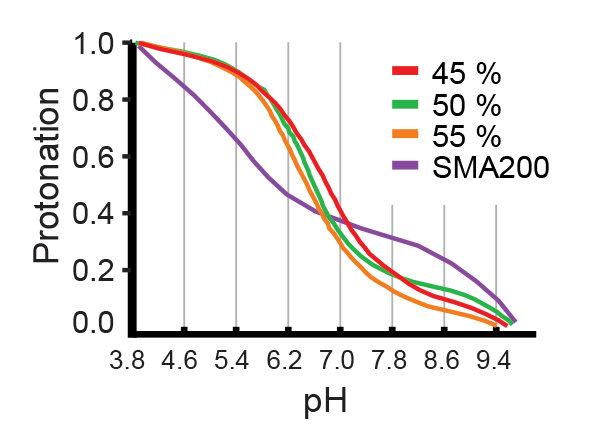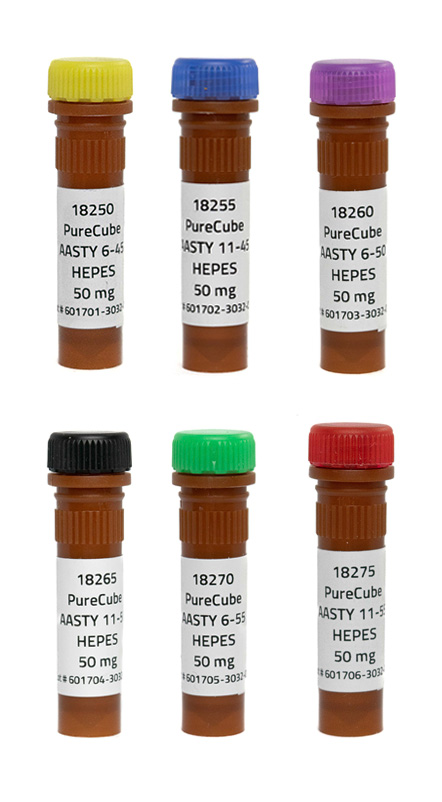AASTY Screening Kit (6x2x50 mg)
Order number: 18285
Description
Each membrane proteins has its own native lipid environment. Therefore, each lipid environment is unique to each membrane protein. And it is this lipid environment that synthetic polymers like AASTYs interact with. Therefore one needs a broader selection of polymers, since there is not one AASTY that fits each phospholipid composition. To address this question AASTYs come in three different ratios of acrylic acid to styrene. The ratios differ in hydrophilic property of AASTY which results in different affinities to varying membrane lipid compositions. The second feature to screen for when it comes to AASTY is the size of the resulting nanodiscs. One of AASTY's greatest features compared to SMA or DIBMA, is that its nanodiscs are quite uniformous in size. Therefore the correct fitting nanodisc size must be determined in before.
Datasheets
| Feature | AASTY 6-45 |
AASTY 11-45 |
AASTY 6-50 |
AASTY 11-50 |
AASTY 6-55 |
AASTY 11-55 |
|---|---|---|---|---|---|---|
| Molecular Weight | 5-6 kDa | 10-11 kDa | 5-6 kDa | 10-11 kDa | 5-6 kDa | 10-11 kDa |
| pH after solving | 7.5 | 7.5 | 7.5 | 7.5 | 7.5 | 7.5 |
| Divalent cationic tolerance | 6 mM | 6 mM | 6 mM | 6 mM | 6 mM | 6 mM |
| Acrylic Acid : Styrene Ratio | 45% to 55% | 45% to 55% | 50% to 50% | 50% to 50% | 55% to 45% | 55% to 45% |
| Shipping Temperature | 2-8°C | |||||
| Storage of lyophilized copolymer | -20°C for several years | |||||
| Storage of dissolved copolymer | 2-8°C for several days | |||||
Lab Results
As every membrane protein, surrounded by its characteristic phospholipid environment, performs differently well with every other polymer, it is generally advisable to screen for the most viable conditions of your protein of interest. However, when you're interested in conditions with lower polymer concentrations, AASTYs are a good choice to start with your experiments.

Video
Watch our video on how nanodisc can help you to overcome one of the most difficult challenges in protein sciences.
FAQ
Is AASTY from Cube Biotech ready to use?
Yes, AASTY is ready to use. You can start directly with solubilization. Read our protocol for more information.
Which pH is suitable for AASTY?
A pH from 7 and up is possible. AASTY does not solubilize if the pH is less than 6.5. As the different AASTY offered differ in composition, they will likely have different optimum pH, dependent on the composition of lipids being solubilized into nanodiscs.
The degree of protonation, and thus the hydrophilic/hydrophobic balance of the copolymer differs across ranges of pH. The effectivity of AASTY for a given protein can be optimized in terms of pH and copolymer used.
The degree of protonation, and thus the hydrophilic/hydrophobic balance of the copolymer differs across ranges of pH. The effectivity of AASTY for a given protein can be optimized in terms of pH and copolymer used.

Which concentrations of AASTY should I use for my protein?
You should screen the polymer to membrane protein ratio as this is system-dependent.
I used AASTY for protein solubilization and a white precipitate appeared - what happened?
AASTY likely precipitated. You should check the pH and ensure that it never drops below 7.0.
How do I quantify the amount of protein after AASTY treatment?
AASTY absorbs light at 280 nm similar to proteins due to the styrene moieties. Therefore, UV absorption is no option here. Components in Bicinchoninic Acid (BCA) assays are likely influenced by AASYY. However, the Bradford assay and SDS-PAGE work.



